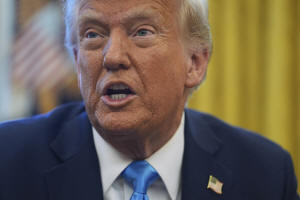Trump’s tariff tactics carry higher economic risks than during his first
term
 Send a link to a friend
Send a link to a friend
 [February 05, 2025] By
PAUL WISEMAN [February 05, 2025] By
PAUL WISEMAN
WASHINGTON (AP) — When Donald Trump started the biggest trade war since
the 1930s in his first term, his impulsive combination of threats and
import taxes on U.S. trading partners created chaos, generated drama --
and drew criticism from mainstream economists who favor free trade.
But it didn’t do much damage to the U.S. economy. Or much good.
Inflation stayed under control. The economy kept growing as it had
before. And America’s massive trade deficits, the main target of Trump’s
ire, proved resistant to his rhetoric and his tariffs: Already big, they
got bigger.
The trade war sequel that Trump has planned for his second term – if it
unfolds the way he's described it – would likely be a different matter
altogether. Trump appears to have grander ambitions and is operating in
a far more treacherous economic environment this time.
His plans to plaster tariffs of 25% on goods from Mexico and Canada and
10% on China – and to follow those up by targeting the European Union –
would threaten growth, and push up prices in the United States,
undermining his campaign pledge to eliminate the inflation that plagued
President Joe Biden.
The tariffs would be paid by U.S. importers, who would then try to pass
along the higher costs to consumers through higher prices.

Trump himself has warned of possible fallout. “WILL THERE BE SOME PAIN?
YES, MAYBE (AND MAYBE NOT!),” Trump said in a social media post Sunday.
“BUT WE WILL MAKE AMERICA GREAT AGAIN, AND IT WILL ALL BE WORTH THE
PRICE THAT MUST BE PAID.”
For now, some of the hostilities are on hold. Trump on Monday paused the
tariffs on Canada and Mexico for 30 days to allow more negotiations
after those countries agreed to do more to stop the flow of illegal
drugs and undocumented workers into the United States.
But he went ahead with the 10% tariffs on China Tuesday. Beijing
promptly retaliated by imposing tariffs on U.S. products, including coal
and big cars. It also is restricting exports of critical minerals and
launching an antitrust investigation into Google.
Trump views tariffs – taxes on imports – as an economic elixir that can
restore factories to the American heartland, raise money for the
government and pressure foreign countries to do what he wants.
During his first term, Trump put tariffs on most Chinese goods and on
imported solar panels, washing machines, steel and aluminum. The tax
increases might have raised prices on those items, but they had little
or no impact on overall inflation, which remained modest. Nor did they
do much to restore factory jobs.
Economists agree that a second Trump trade war could be far costlier
than the first.
“That was then. This is now,’’ said trade analyst William Reinsch of the
Center for Strategic and International Studies. That is why the stock
market briefly fell sharply Monday on anticipation of the tariffs,
before rebounding on news of the pause with Mexico and Canada.
During Trump’s first term, his trade team carefully focused its tariff
hit list to avoid or at least delay the impact on consumers. They
targeted industrial products and not those “that would show up on
Walmart’s shelves,” said Reinsch, a former U.S. trade official. "That
tamped down the impact.’’
This time, by contrast, the tariffs are across the board – although the
tariffs Trump had planned and then paused would have limited the levy on
Canadian energy to 10%, showing that he was mindful of how much
Americans in northern and midwestern states depend on oil and
electricity from north of the border.

[to top of second column] |

President Donald Trump speaks to reporters as he signs executive
orders in the Oval Office of the White House, Tuesday, Feb. 4, 2025,
in Washington. (AP Photo/Evan Vucci)
 In Boca Raton, Florida, the toy
company Basic Fun is preparing to raise prices and absorb a hit to
profits when the tariffs land.
Ninety percent of Basic Fun’s toys come from China, including Tonka
and Care Bears. CEO Jay Foreman says the price on the Tonka Classic
Steel Mighty Dump Truck is likely to rise later this year from
$29.99 to as much as $39.99.
Five years ago, the Trump administration spared toys, exempting them
from its China tariffs. This time, Foreman said, "we are now just
going to forecast a lot of money draining out of the company.''
In addition to the threats to Canada, Mexico and the EU, Trump has
threatened a worldwide tariff of 10% to 20%. The breadth of his
potential targets means it will be much harder for companies to
escape his tariffs.
In his first term, many companies dodged his China tariffs by moving
production to Mexico or Vietnam. Now, suppliers anywhere could wind
up in Trump's crosshairs. “It sends the signal that no place is
safe,’’ said Mary Lovely, senior fellow at the Peterson Institute
for International Economics.
Also worrying, economists say, is a retaliation clause the Trump
team inserted in the tariff orders he signed Saturday.
If other countries retaliate against Trump’s tariffs with tariffs of
their own – as China did and Canada and Mexico have threatened --
Trump will lash back with still more tariffs. That risks “setting
off a spiraling trade war’’ of tit-for-tat tariffs and
counter-tariffs, said Eswar Prasad, professor of trade policy at
Cornell University.
But the biggest difference is the economic backdrop Trump must
contend with this time.
Six years ago, inflation was low — maybe even too low, the Federal
Reserve fretted. Trump's first-term tariffs didn't make a dent.
Inflation isn't so benign anymore. Prices surged in the unexpected
boom that followed the end of COVID-19 lockdowns. Inflation has come
down from the four-decade high it hit in mid-2022, but it's still
stuck above the Fed's 2% target and hasn't shown much improvement
since summer.

Trump’s tariffs could rekindle the inflationary trend and convince
the Fed to cancel or postpone the two interest rate cuts it had
anticipated this year. That would risk keeping "interest rates at
their current elevated level for a longer period in 2025. That will
push up mortgage and loan borrowing rates ... and reduce real
growth,’’ said Boston College economist Brian Bethune.
For now, businesses, investors and U.S. trading partners are waiting
to see what the unpredictable Trump will do next. Will he re-impose
the tariffs on Canada and Mexico after 30 days? Will he really go
after the EU? Or make good on his threat of a universal tariff?
Outside a Harris Teeter supermarket near downtown Raleigh, North
Carolina, Jacobs Ogadi had in his shopping bag an avocado, which
almost certainly came from Mexico.
The 62-year-old mechanic said it “doesn’t take a rocket scientist’’
to know that Trump’s tariffs run counter to his promises to rein in
inflation. “If it goes up 25%, it’s not the government, it’s not the
Mexican people paying for it,’’ he said. “Who pays for it? Us.’’
____
AP writers Anne D’Innocenzio in New York and Gary Robertson in
Raleigh, North Carolina, contributed to this story.
All contents © copyright 2025 Associated Press. All rights reserved |